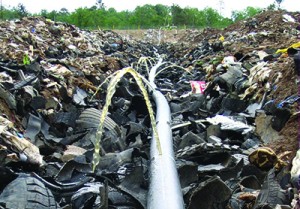 Leachate, the liquid created when water passes through solid waste, poses a challenge for landfill owners. Potentially harmful to the environment and to people, leachate can contain compounds such as arsenic or vinyl chloride. This wastewater creates the need for solutions that protect communities and fall within budgets set aside for waste disposal operations. Here are a number of factors that need to be considered when deciding how to efficiently manage leachate at a landfill.
Leachate, the liquid created when water passes through solid waste, poses a challenge for landfill owners. Potentially harmful to the environment and to people, leachate can contain compounds such as arsenic or vinyl chloride. This wastewater creates the need for solutions that protect communities and fall within budgets set aside for waste disposal operations. Here are a number of factors that need to be considered when deciding how to efficiently manage leachate at a landfill.
Prevention Better Than Cure
Start by implementing strategies that prevent disposal of contaminants at landfills. Initiatives that encourage households and businesses to dispose of waste properly can reduce the buildup of harmful substances in landfills. Household items like pharmaceuticals, paint, electronics, batteries and appliances can all be disposed of in ways that eliminate leachate problems.
From a landfill owner’s perspective, a waste acceptance and inspection programs can also minimize the amount of hazardous material that enters the landfill. Industrial waste generators, for example, provide source and chemical information to verify whether a material is hazardous or not.
Pretreatment: A Careful Consideration
When waste begins to degrade, natural biological and chemical processes are at work. The leachate often contains harmful metals and volatile organic compounds (VOCs); it also typically has high biochemical oxygen demand (BOD) and chemical oxygen demand (COD).
Chemicals often must be removed from wastewater through pretreatment to meet publicly owned treatment works (POTW) standards. Biological reactors, surface ponds, constructed wetlands, physical or chemical plants and reverse osmosis are some of the ways to reduce chemical content. At the Crow Wing County Landfill in Brainerd, Minn., for example, leachate is treated in four ponds that collectively form a reduction system featuring primary treatment, secondary treatment and long-term storage.
Nature’s Course: Land Application
Leachate that has been collected and pretreated can be absorbed by the land itself as a means of disposal. Through a process called phytoremediation, trees such as willows and hybrid poplars, as well as some grasses, can absorb certain contaminants like metals, nitrogen and VOCs. Similarly, many surface soils can absorb unwanted leachate. These land application solutions have demonstrated positive results in Maryland, Oregon and elsewhere.
Recirculation: A Fluid Solution
Using a series of horizontal pipe manifolds or a spray application, treated leachate can be circulated back into landfill waste to improve conditions. This offers these benefits:
Faster Decay. Moisture speeds the breakdown of organic materials. With proper leverage, moisture levels can double or triple the rate of landfill waste decay. If regulations allow, surface water, wastewater, sludge and biosolids can create a bioreactor that promotes microbial activity in the waste, improving leachate quality and reducing contamination as landfills reach capacity.
Quicker Waste Stabilization. The additional water weight speeds the rate at which landfill waste compacts, extending the site’s life. For example, if a typical cubic yard of waste at a landfill contains 1,000 pounds of garbage, recirculating water through the waste can expand that to as much as 2,000 pounds per cubic yard, doubling the useful life of a site.
Alternative Gas Production. Additional moisture within landfill waste promotes development of methane gas. Landfill owners can implement an energy recovery project by collecting and using this gas. For example, at the Sioux Falls Landfill near Sioux Falls, S.D., recirculating leachate contributes to more than 2,000 cubic feet per minute of landfill gas, which is then used as an alternative to natural gas, increasing landfill revenue.
Evaporation: A Disappearing Act
In drier climates, evaporation through large surface storage ponds is a common solution for reducing leachate. Other evaporative methods that have recently been employed in northern climates include impact sprayers or commercial misters on the working face or intermediate covers of landfills to evaporate leachate. Similarly, installing pump systems in a storage pond to spray leachate over the water surface is common in colder climates. When the leachate is sprayed onto the black plastic liner, the water evaporates, reducing the leachate volume.
Constructed Wetlands
A lined, submerged wetland can provide leachate treatment by using its natural plant and soil processes to break down contamination. Aerated zones promote aerobic and anaerobic treatment, removing metals and organics.Discharging treated leachate into seepage wetlands allows evaporation to occur before the liquid percolates into the subsurface.
Going the Distance with Hauling
Of course, you can also minimize leachate by hauling it away treatment and disposal. Hauling can be an operational challenge and a large expense, both monetarily and environmentally. For example, in 2013, Sioux Falls hauled 7.8 million gallons of leachate to its POTW. The 25-mile round trips resulted in more than 90,000 pounds of carbon dioxide emissions. In an effort to reduce the effects of hauling, the city is considering phytoremediation as an alternative.
What do you think of these solutions for reducing leachate in landfills? Which methods do you think are the most effective? Have you come across any other methods employed by landfill owners to reduce hazardous chemicals in wastewater? We’d like you to share your opinions on this ongoing issue.
Fred Doran is a department manager in the Environmental Group of Burns & McDonnell, where he leads solid waste projects with particular experience in leachate and landfill gas management systems. He is a registered professional engineer in five states and is a member of the Landfill and Landfill Gas Divisions of the Solid Waste Association of North America (SWANA).
A version of this article original appeared in Waste360 – Landfill Leachate: Wringing Waste from a Common Solution
Photo Credit: Waste360
